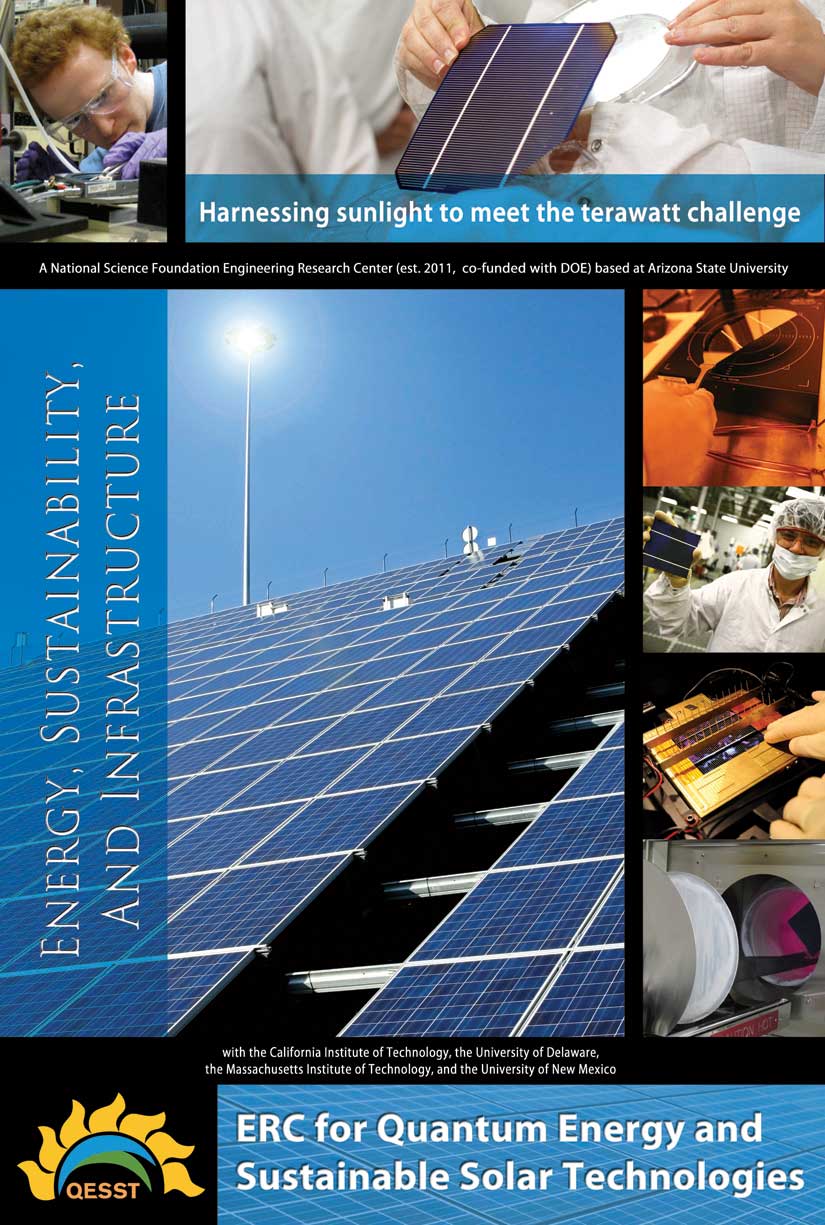ERC for Quantum Energy and Sustainable Solar Technologies

Electricity is the lifeblood of modern society, powering everything from cities to pacemakers. With demand increasing, the electricity generating system faces challenges. These include harmful environmental impacts, threats to national security, resource supply problems, difficulties in powering autonomous applications, and over a quarter of the world's population without access to electricity. These all indicate the need for a new electricity generation system. QESST addresses these challenges by supporting a system of photovoltaic science and innovation—a system that breaks away from the waste and inefficiencies of unsustainable fossil fuels and generates power using our favorite sustainable and unlimited resource: the Sun. QESST focuses on advancing photovoltaic science, technology and education in order to address one of society's greatest challenges: sustainably transforming electricity generation to meet the growing demand for energy. The Center is co-funded by NSF and the Department of Energy's Office of Energy Efficiency and Renewable Energy. The NSF-DOE collaboration allows leveraging of government funding to advance PV technology from fundamental research to commercialization in partnership with industry via the ERC innovation ecosystem and connections with DOE programs and opportunities.
Energy and Sustainability
Energy, Sustainability, and Infrastructure
Location
Lead Institution
Start Year
Website
Fact Sheet
Core Partners
Center News and Achievements
Locations
Additional Information
Focus
QESST seeks to transform the existing electricity generation system, making it sustainable, ubiquitous, and multifunctional, by developing photovoltaic and quantum energy converters, which fundamentally alter how energy is used.
Graduation Date
Education Web Page
Research Opportunities for Undergrads
Student Leadership Council
ERC for Quantum Energy and Sustainable Solar Technologies

Electricity is the lifeblood of modern society, powering everything from cities to pacemakers. With demand increasing, the electricity generating system faces challenges. These include harmful environmental impacts, threats to national security, resource supply problems, difficulties in powering autonomous applications, and over a quarter of the world's population without access to electricity. These all indicate the need for a new electricity generation system. QESST addresses these challenges by supporting a system of photovoltaic science and innovation—a system that breaks away from the waste and inefficiencies of unsustainable fossil fuels and generates power using our favorite sustainable and unlimited resource: the Sun. QESST focuses on advancing photovoltaic science, technology and education in order to address one of society's greatest challenges: sustainably transforming electricity generation to meet the growing demand for energy. The Center is co-funded by NSF and the Department of Energy's Office of Energy Efficiency and Renewable Energy. The NSF-DOE collaboration allows leveraging of government funding to advance PV technology from fundamental research to commercialization in partnership with industry via the ERC innovation ecosystem and connections with DOE programs and opportunities.
|
LocationTempe, Arizona
|
Lead InstitutionArizona State University
|
Start Year |
Website |
Fact SheetDocument
|
Core PartnersCaltech
University of Delaware
MIT
University of New Mexico
|
FocusQESST seeks to transform the existing electricity generation system, making it sustainable, ubiquitous, and multifunctional, by developing photovoltaic and quantum energy converters, which fundamentally alter how energy is used. |
Graduation Date |
Education Web Page |
Research Opportunities for Undergrads |
Student Leadership Council |
Center News and Achievements
Locations
ERC for Quantum Energy and Sustainable Solar Technologies

Electricity is the lifeblood of modern society, powering everything from cities to pacemakers. With demand increasing, the electricity generating system faces challenges. These include harmful environmental impacts, threats to national security, resource supply problems, difficulties in powering autonomous applications, and over a quarter of the world's population without access to electricity. These all indicate the need for a new electricity generation system. QESST addresses these challenges by supporting a system of photovoltaic science and innovation—a system that breaks away from the waste and inefficiencies of unsustainable fossil fuels and generates power using our favorite sustainable and unlimited resource: the Sun. QESST focuses on advancing photovoltaic science, technology and education in order to address one of society's greatest challenges: sustainably transforming electricity generation to meet the growing demand for energy. The Center is co-funded by NSF and the Department of Energy's Office of Energy Efficiency and Renewable Energy. The NSF-DOE collaboration allows leveraging of government funding to advance PV technology from fundamental research to commercialization in partnership with industry via the ERC innovation ecosystem and connections with DOE programs and opportunities.
Energy and Sustainability
Energy, Sustainability, and Infrastructure
Location
Lead Institution
Start Year
Website
Fact Sheet
Core Partners
Center News and Achievements
Additional Information
Focus
QESST seeks to transform the existing electricity generation system, making it sustainable, ubiquitous, and multifunctional, by developing photovoltaic and quantum energy converters, which fundamentally alter how energy is used.
